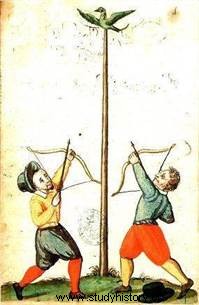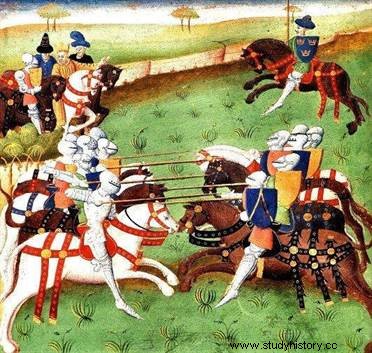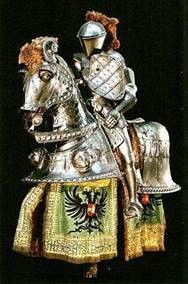 Gradually organized into tournaments, the jousting was a medieval combat of men on horseback who fought by means of a spear. Favorite occupation of nobles in the Middle Ages , the tournaments experienced an extraordinary vogue in France from the 12th century before spreading to Germany and England. Originally war games and sometimes deadly, they are transformed into a spectacle. These are ritualized simulacra of violent fights between two teams in the open countryside and later of jousts opposing the knights competing in pairs during chivalric festivals, given in the 14th century "in honor of the ladies", during ceremonies, princely weddings and other receptions...
Gradually organized into tournaments, the jousting was a medieval combat of men on horseback who fought by means of a spear. Favorite occupation of nobles in the Middle Ages , the tournaments experienced an extraordinary vogue in France from the 12th century before spreading to Germany and England. Originally war games and sometimes deadly, they are transformed into a spectacle. These are ritualized simulacra of violent fights between two teams in the open countryside and later of jousts opposing the knights competing in pairs during chivalric festivals, given in the 14th century "in honor of the ladies", during ceremonies, princely weddings and other receptions...
Knights jousting and weapon games
Nobles like to distinguish themselves with weapons in hand, confrontations for which they train daily from an early age. A formative exercise for jousting, the ring race sees skilled knights aiming for a ring attached to a post. The lords also encourage shooting at the papegaut or wrestling which figure as interludes in the weapon festivals. For "the safety and defense of the kingdom" an edict of King Charles V in 1369 prohibits dice and other games favoring bow and crossbow exercises, "esbatements" more suitable for their military nature.
 Learning about war while having fun is what the young boys of the aristocracy who practice the Behourd (fencing on horseback), and the handling of wooden swords. The courtyards of the castles are schools where young athletes are trained, who must acquire flexibility, agility and vigour. They practice running, stone or javelin throwing, high jumps or full-armed jumps, fencing (wrestling with sticks or swords) which are muscular entertainments preparing for military art.
Learning about war while having fun is what the young boys of the aristocracy who practice the Behourd (fencing on horseback), and the handling of wooden swords. The courtyards of the castles are schools where young athletes are trained, who must acquire flexibility, agility and vigour. They practice running, stone or javelin throwing, high jumps or full-armed jumps, fencing (wrestling with sticks or swords) which are muscular entertainments preparing for military art.
La Quintaine, difficult test, is an articulated wooden mannequin placed at the top of a post called ''estache''. Hurried at a gallop, the jouster must strike a violent spear against the target equipped with a hauberk and a shield to knock it down, aiming it right in the middle. If the jouster does not strike straight or break his spear he risks being unhorsed, making a fool of himself in front of the assembly.
While the nobles wielded the sword, spear and mace, bourgeois and peasants practiced with sticks or fists, archery or the crossbow. Archery skill is paramount in the event of a siege. The papegaut (parrot) is a bird painted green placed at the top of a perch or on a rampart to serve as a target. Papegaut brotherhoods bring together the best shooters and distribute prizes. A formidable weapon in the hands of the Bretons, the iron stick or "thrust" already appears in a poem by the troubadour Marcabrun in the 12th century.
Tournaments, mock battles
Practiced regularly on St John's Day, Pentecost or in great circumstances (princely weddings, plenary courses) the games of arms took place in the 12th and 13th centuries on an immense field exercise pitting two armed groups against their leaders and soldiers. During these pitched battles, we face each other with real weapons with sword, spear and mace, as a team from province to province. Horses and riders line up in two lines for the maneuver to be performed. At the signal given by the trumpets or by the bell of the tournament, the troops charge in a great crash with masses of arms and swords. Sometimes the tournoyeurs put so much ardor into the confrontation that they forget the sporting dimension and that fighters lose their lives there. The Duke of Brittany Geoffroy Plantagenêt died at the age of twenty-eight from an injury received at a tournament given in his honor in 1186!
This expression summarizes the melee tournaments where the stake is not only sporting:prisoners are taken there (whose ransom is expensively changed) and horses richly rigged as well as the weapons of the vanquished belong to the victor, representing a very lucrative trade which gives rise to controversies on the ground. Some unscrupulous knights take advantage of the confusion to enrich themselves. Many barons and lords have ruined themselves to parade in these festivities of arms! This is why the Council of Clermont condemns in 1130 these detestable and mercantile games.
Show tournaments in the 14th and 15th centuries
The trouvère Jacques Bretel evokes in his writings "The Tournaments of Chauvency", the evolution of chivalrous society. The fights carried out with full bridle in the open fields are transformed into an “elegant” sport practiced in an enclosed space under the spectator stands, the “hoardings”. These tiers, magnificently decorated with tapestries, crests, flags and banners, welcome princes, ladies and young ladies dressed in their finest finery.
The fighters, kings-at-arms and squires make a solemn entrance, with their crests and extravagantly oversized helms. The crest, a sort of plume surmounting the helmet, is decorated with various motifs:heraldic animals, horns, branches, peacock or ostrich feathers, and enhanced with a banner on the "valance" floating in the wind. The knights display bright colors:red, green or blue on their shield, their banner or the cover of the horses. You don't spin to get rich but to show your skill and rank with all the necessary panache. The staging is that of courtly romances whose nobility cultivates a nostalgic taste.
 The day before the tournament takes place the review of swords, banners and helmets where we recall the laws of chivalry ( see chivalry in the Middle Ages). The knights present themselves on the appointed day preceded by their trumpet minstrels and followed by their squires. The appellant's emblazoned banners are brought and planted in the lists. The two teams fight until the trumpet-sounding retreat. The winners' prize is awarded by the queen of the tournament accompanied by her bridesmaids, the king of arms and the judges.
The day before the tournament takes place the review of swords, banners and helmets where we recall the laws of chivalry ( see chivalry in the Middle Ages). The knights present themselves on the appointed day preceded by their trumpet minstrels and followed by their squires. The appellant's emblazoned banners are brought and planted in the lists. The two teams fight until the trumpet-sounding retreat. The winners' prize is awarded by the queen of the tournament accompanied by her bridesmaids, the king of arms and the judges.
Justing for the love of ladies
The desire to please the ladies is no stranger to staging tournaments. Already in the time of the troubadours, the knights lend themselves to courtly love games. The champions will swirl in the hope of seducing a beautiful heiress. The sports meeting becomes a place of seduction. According to the chronicler Jean d'Authon, the ladies were so adorned at a tournament held in 1507 in Milan in the presence of King Louis XII, that ''it was enchanting''.
The erotic element is evident in the custom of ladies offering their favors to their favorite knight. It is a scarf, a veil, a sleeve (some dresses have sewn sleeves so that they come off for this purpose) or other adornment with which the chosen adorns the top of his helmet. , his shield or his coat of arms. In the frenzy of the fights, the ladies offered so many ornaments to the knights that in the end they found themselves bareheaded with their sleeveless coat, without shirt or chasuble and laughed at their adventure "not having noticed of their clothing! »
Arms and armor of knights
 Highly regulated, tournaments require specific equipment very different from that of war, requiring the wearing of a light cuirass under which is a corset padded with canvas and oakum to cushion the blows of the mace and the sword. The Tournament Helm is squared with large diamonds on the front for breathing and viewing.
Highly regulated, tournaments require specific equipment very different from that of war, requiring the wearing of a light cuirass under which is a corset padded with canvas and oakum to cushion the blows of the mace and the sword. The Tournament Helm is squared with large diamonds on the front for breathing and viewing.
For jousting, single combat, armorers reinforce the helm by removing the large openings, replacing them with a narrow slit at eye level. This helm, named ''toad's head'' because of its shape (weighing up to 9 kg) is fixed to a steel corselet by enormous hinges. The armor of the jouster is of considerable weight to give more power to the spear stroke and fixity to the rider. The cuirass is reinforced on the left side by a gauntlet on the forearm, a steel plate protecting the shoulder. Attached by a strap to the armour, the shield or targe is a wooden shield covered with leather or deer horn with a raised grid allowing to dodge the blows of spears.
The so-called courtly lance, furnished with a ratchet (point with three rounded ends in order to distribute the impact and avoid piercing the armor) is light and fragile to break easily on the helmet or the shield of the adversary. The rider must brace himself on his mount so as not to “jerk in the saddle”. It takes a lot of dexterity to direct the blow. This combat is followed by a jousting on foot "at the barrier" with confrontation with an ax or mace.
Henry II's fatal joust
In June 1559, brilliant chivalrous feasts were given on the occasion of the marriages of Marguerite, the king's sister, with the Duke of Savoy and of Elisabeth of France with Philip II of 'Spain. The lists are established in the Saint-Antoine district, in front of the Royal Hotel des Tournelles.
 On the 30th, after having competed several times, the king, wearing the colors of his mistress Diane de Poitiers decided ( despite the predictions of the Queen's astrologer) to grant himself a last spear of revenge against the Earl of Montgomerry who made him "jerk off". Unfortunately, the opponent's spear breaks and pierces the king's visor, going right through his eye. The king will agonize for ten days in great suffering.
On the 30th, after having competed several times, the king, wearing the colors of his mistress Diane de Poitiers decided ( despite the predictions of the Queen's astrologer) to grant himself a last spear of revenge against the Earl of Montgomerry who made him "jerk off". Unfortunately, the opponent's spear breaks and pierces the king's visor, going right through his eye. The king will agonize for ten days in great suffering.
The tragic death of Henry II precipitated the decline of these games so prized by the nobility.
Bibliography
- Tournaments and Weapon Games in the Middle Ages, by Gérard Lomenec'h. Editions Ouest-France, February 2015.
- Break the spears! Knights and Tournaments in the Middle Ages, by Sébastien Nadot. Otherwise, 2010.
- The Knights of the Middle Ages, by Cédric Delaunay. Metive, 2017.
